Great to See Grizzly Mum and Playful Yearlings Doing Well into Year 2
We witnessed this new Grizzly Bear Family last Year and it is Great to see them doing well this year. In another year or two, these Cubs will be on their own, but this type of relaxed play says they are happy and healthy right now.
Big Grizzly Mum and Spring Cubs on the Hunt for Protein
This Big Grizzly Mum is an expert in keeping her protein up with insects. Here she is teaching her Spring Cubs both how and the value of this crucial food source. The added pressure of keeping her Cubs safe and away from Big Boars forces her to hone these skills even more.
Grizzly Bear Cubs Battle of Learning to Swim is Inescapable
In this area of Canada's Rockies, Grizzly Bears cross Athabasca River frequently. When the river water is higher and faster this time of year however, it could be life threatening for Spring Cubs. This Big Grizzly Mum decides not to risk it yet as she senses the cubs are just not ready.
Grizzly Bear Tension Rises as Mating Season Begins
While larger Male grizzly bears often intimidate and drive away smaller males during the mating season, these two are suspected of being Siblings that are close in size. We are not certain, but suspect this fight escalated as a result of the obvious and it is interesting that the third Grizzly Bear interferes, possibly showing who it favors. They are not harmed at all with being shot by these colors (paint ball type gun), and because there are so many Grizzly Bears in the area, it does help identify them.
Biggest Grizzly Mum Shows Up with Newborn Cubs
This Grizzly Mum has Awesome genetics and is possibly the largest Sow we have witnessed in this area. She mated with a Huge Boar last season, so these Grizzly Cubs have Great Genetics on their side. She has lost a lot of weight while travelling a great distance after hibernation and supporting two cubs. We hope she will be back in fine form very shortly and this becomes a successful Family!
Biggest Grizzly Bear Boar Seen this Year Happy with Eating Greens for Now
In Spring and early Summer, grizzly bears consume a variety of greens as part of their diet. Grizzly bears feed on new shoots and blades of grass that emerge during the spring and a wide range of herbaceous plants and forbs. These include plants like dandelions, clovers, fireweed, cow parsnip, and other flowering plants that grow in meadows, clearings, and open areas. Plant species consumed by grizzly bears vary based on their location and the availability of vegetation in their habitat. Grizzly bears are opportunistic feeders and can alter their diet according to seasonal changes and local food availability.
Big Beautiful Grizzly Sow First Sighting this Year!
Our First Sighting of this Big Girl out of Hibernation was a nice surprise. She was in Great condition.. looking really Big and Strong as She begins her travels. Her Paws and Nose were never still for long as she searches for scents of substance. The beginning shows a clip of her Hunting Ground Squirrels along with when she had a newborn Cub Last Year, to compare. Her Gifted structure looks even bigger and fuller this year. We were hoping to see Her trying Motherhood again this year, but no luck on that account. Regardless, it was an incredible encounter that took place in a perfect setting with lots of safe space to observe. She is a Great Teacher that the Rockies are Lucky to Have! *We had a little fun on the beginning of this.. hope it brings a smile your way.
Tiny Spring Grizzly Bear Cubs First Exploration
Tiny Spring Grizzly Bear Cubs First Exploration out in Canada's Rocky Mountains.
Big Grizzly Bear Boar Feeding on Moose Bull Carcass
The Most Recent Day we saw this Big Grizzly Boar on the Large Moose Bull Carcass. One of the largest Grizzly Bear Boars in this area, feeding on also one of the Largest Moose Bulls in this area. Thank you for your patience with this video, it was cropped in from about 1km away. Thank You to Those that stayed to visit and help pass the time while we waited for this Big Grizzly to make another appearance.
Big Grizzly Bear Feeding on Moose Bull Carcass
This would be Considered one of the largest Grizzly Bear Boars in this area, feeding on also one of the Largest Moose Bulls in this area. There was no sign of struggle on the far side of this lake, so it is not suspected that a Bear killed this Moose Bull. This big Grizzly is Certainly making sure no Calorie goes to waste. An entire Day of eating berries(this time of year) for this Grizzly May be equaled in just a few mouthfuls of this Calorie Dense Carcass, which ends up feeding many.
In just a few more Days, there may be no sign of this Moose Bull Carcass, as Nature absorbs all.. even Fur disappears and becomes insulation for Birds tree nests, etc.
Thank you for your patience with this video, it was cropped in from about 1km away.
Berry Season is a Time For Extra Care
It is Berry Season now and that means a time to be Extra Careful when out in Favorite Shared Spaces. Bears can become very focused on eating Berries and when in dense bush, Surprise Encounters are Far More Common. If a Bear knows you are there, or approaching on a trail, the chances of a difficult situation is less likely. Be Safe out there!
Grizzly Bear Grabs and Runs from a Moose Bull Carcass
This Grizzly Bear came in, grabbed what He could, and hastily ran back into Forest cover.. spending only about 3 minutes out in the open. We heard another Bear.. a Black Bear, was seen on this Moose carcass earlier on this day. There was apparently no signs of struggle on the far side of the Lake shore, and the Moose Bull was very large for this area of the Canadian Rockies.. so, likely not killed by these Bears. *We are cropping quite a bit from a long distance and Thank You for your patience with Us there.
Wonderful Grizzly Family Makes Another Appearance
Grateful to see this amazing Grizzly Family for a short appearance before they head up in altitude towards new green growth. We may see them again during berry season, but just knowing they are doing well is wonderful. As newborns, these cubs had something about them that was particularly amazing as you can see.
Huge Mature Grizzly Mum with Newborns
This is probably the Most Mature and Largest Grizzly Sow in this area. She, or her Sister/Daughter can be easily confused with which Bear raised the 3 Amigos. Regardless, it was a very pleasant surprise to see this Awesome Grizzly Bear with 3 Cubs of the Year/Newborns.
Biggest Grizzly Seen in the Area So Far
The Biggest Grizzly Seen in the Area So Far is such a magnificent sight. We thought a little tribute to this amazing Apex creature was in order, so here is a good look at this incredible fella. We are not sure, but He may have recently been seen mating with one of the biggest Sows in the area. If so, their offspring will be exceptionally gifted in the size department.
First Sighting of Mature Grizzly Mum with New Offspring
It Appears the 3 Amigo's Mum is now raising/protecting 2 newborns(coy). Back in 2019, she had 3 that looked exactly like these 2(little "Spirit" faces), but She was quite a bit Heavier at the same time of year back then. The cooler Spring sure has seemed to delay their ability to put on weight. Hopefully, we get lots of moisture in the immediate and this Family finds a safe space far away from the Highways.
An Amazing Grizzly Family Today and as Newborns
Here is our first sighting of this Amazing Grizzly Family Today and as Newborns. They looked like they weathered hibernation very well! The Family were seen on Mountain Peaks in late Spring and now with some slight adjustments to their territory, down in the Valley Bottom. Many call this Famous Mother "Grizzma" as she is very well known, such a Beautiful Mother Bear, and has an amazing temperament. Along with some footage of Grizzma and Her Cubs today, we have included our First Sighting of them back in 2020, as newborns. We Hope Cubs and Mum stay together for the remainder of this year for their safety, but we can see that it may be difficult for all of them to occupy the same Den when that time comes.
Grizzly Bear Siblings Doing Well on Their Own
These 2 Grizzly Bear Siblings were of a group of 3, but just these two stayed together while the third one ventured out on his own. So far, these two have been doing well bouncing on and through territorial edges of many larger Bears. Here you can also see that you have to be bear aware everywhere as common hiking hubs contain many trail junctions often also used by Grizzly and Black Bears. We hope to see these two beautiful Bears continue to do well in this amazing space.
Biggest Beautiful Grizzly Sow
The Biggest Beautiful Grizzly Sow we have seen in this area appears late in an evening, much to our Delight! Hopefully, She will pair up with an equally awesome Male during this Grizzly Bear mating season.
Happy Grizzly Siblings or a Mating Pair?
This is one of the most interesting pair of Grizzly Bears right now as no one seems to know. We have heard that they are Twins, a Mating Pair, but what we witnessed today.. possibly a Mum with a Teenage Cub. Regardless.. they are wonderful to Witness.
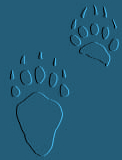
Grizzly or Brown Bear Tracks.
Human - Grizzly Bear Conflicts
Human Fatalities from Bear Attacks in North America >>Grizzly Bear / Brown Bear / Kodiak Bear Facts
Taxonomy: While there has been much confusion about the taxonomy of brown bears (Ursus arctos), taxonomists agree there are at least two subspecies in North America -- the grizzly bear (U. a. horribilis) and the Kodiak bear (U. a. middendorffi). The Kodiak bear has lived separately on Kodiak, Afognak, and Shuyak Islands in southwestern Alaska for thousands of years with no interbreeding with other populations. However, there is no such geographic demarcation between the coastal U. a. gyas and the inland U. a. horribilis. There is a continuum of difference between the larger coastal brown bears and the interior individuals that are generally called grizzly bears.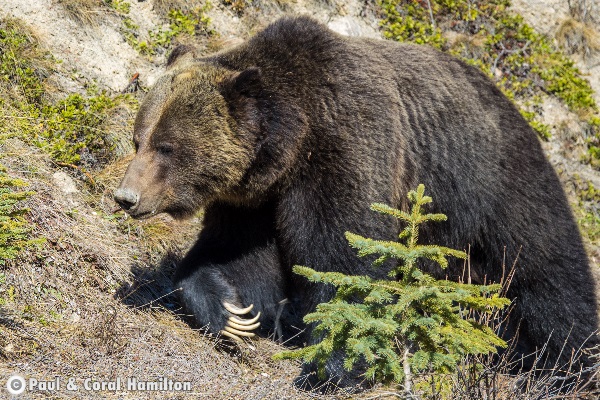
Simply separating the Bears' names are that Coastal brown bears have a greater amount of animal protein in their diet, achieve larger size, and have slight differences in coloration.
Home Ranges: Grizzly bears can be found in the Canadian provinces of British Columbia, Alberta, Yukon, and the Northwest Territories; and the US states of Alaska, Idaho, Wyoming, Washington, and Montana. In general Bears' home rangea are between 10 and 380 square miles. A grizzly bear's home range is basically inland - away from major bodies of water. In most cases, a grizzly bear's home range includes an area of forested land or shrub cover, which is used mostly for escape.
Gathering and Eating Food: Grizzly bears feed on berries (blueberries, bearberries, buffalo berries, etc.), roots, bulbs of plants, ground dwelling rodents, and whitebark pine nuts. Sometimes grizzlies will locate a cache of these nuts that a ground squirrel has stored for the winter. With their excellent sense of smell, grizzlies can locate carrion from miles away and will readily feed on it. These easy meals are fiercely protected by any Bear.
Grizzlies may also prey on moose, elk, mountain goats and mountain sheep. During the spring months, grizzlies also feed on the calves of these animals.

Another major food source for grizzlies are cutworm moths. During the summer months in the Yellowstone area, these moths congregate on sub-alpine plants located above the timberline at elevations higher than 10,000 feet. During the early morning hours these moths drink nectar and then during the day they cluster on the surrounding rocks. Grizzlies from all around climb to these high elevations to consume 10,000 to 20,000 of these moths a day. At times like this, when food is abundant, numerous grizzlies will congregate and feed together. Once the food source is depleted, the grizzlies will go their separate ways in search of other food.
Kodiak bears generally rely on the same types of food as grizzlies, with one addition. Living in coastal areas provides these bears with a rich supply of protein. These coastal areas are so rich in salmon that a 40% higher density of brown bears can be supported in those locations.
Face: Brown bears have a concave or dish-shaped face.
Paws: Grizzly bear paws are black or brownish in color with wrinkled skin on the pads.
Shoulder Hump: Brown bears have a distinguishing shoulder hump. This hump is actually a mass of muscle, which enables brown bears to dig and use their paws as a striking force. This hump may have evolved as Grizzly Bears focused more on digging for roots; the muscle mass being an adaptation through natural selection.
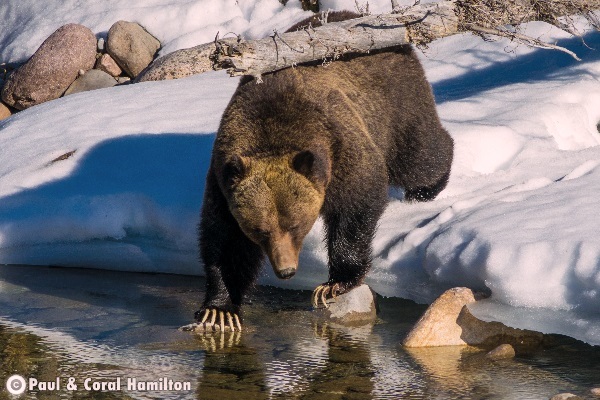
Claws: Brown bear claws are long and curved, ranging in color from yellow to brown. In rare cases grizzlies have been observed with white claws. These claws are used to dig up roots and bulbs of plants as well as to excavate den sites. While extremely strong, Grizzly claws are not adapted well for tree climbing.
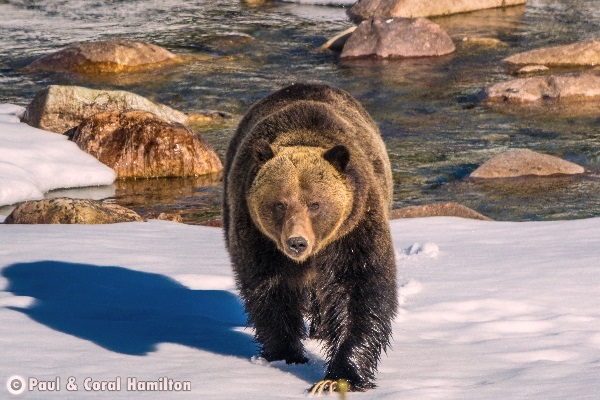
Tracks: The toes fall close together and nearly in a straight line in a brown bear track. The toe pads are generally touching each other with the smallest toe on the inside of the track. Impressions from the fore claws are usually found far in front of the toes because the claws are twice as long as the toe pads. The front tracks of brown bears measure 6-8 inches long (excluding the Bear's heel) and 7-9 inches wide. Hind tracks measure 12-16 inches long and 8 to 10.5 inches wide.
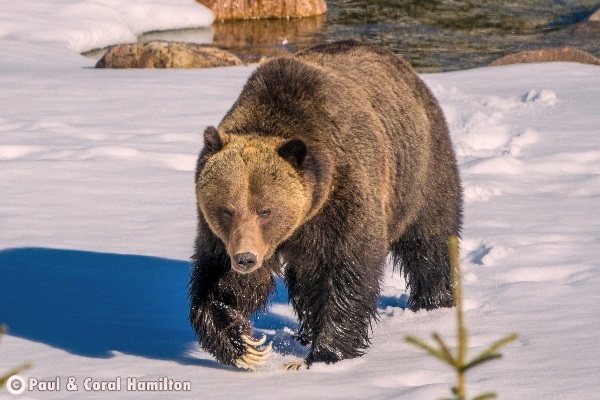
Coloration: Grizzlies range in color from white, blonde, brown, black and shades there of. The tips of most fur are lighter in color giving them that "grizzled" effect.
Growth and Development: Brown bears can weigh 150-200 pounds at the end of their first year of life. They reach sexual maturity between 4 and 5 years and are considered fully grown by 8 to 10 years of age.
Weight: Females reach their maximum weight of 270 to 770 pounds in about 8 years. Males reach their maximum weight of 330 to 1200 pounds in 12 years. The heavier a female is, the better are her chances of having cubs. The heavier a male is the better chance he has of successfully breeding with a female. Males are 20% to 200% as heavy as females.
Kodiak bears often grow to 10 feet long and weigh well over 1,000 lbs.
Surviving in the Wild: In general, Grizzly bears will flee as soon as they detect humans. Finding food, finding mates, and avoiding being preyed upon govern a brown bear's life.
Most brown bears are active during the morning and early evening hours. During the daytime they rest in day beds, often constructed in dense cover to escape the heat. During the late summer and fall months, when they are fattening up for the long months of hibernation, brown bears may be active throughout the day. As food items become scarce, the brown bear's territory increases. Within their home range, brown bears use a wide variety of habitats. Brown bears travel from alpine food sources to estuaries, to berry patches, to salmon spawning sites - visiting each site when its particular food source is available.
Dens: Dens must provide protection and security during the winter months. Brown bears can excavate a den but often use rock caves and hollow trees. Dens are dug in dry, stable soil where winter temperatures will remain above freezing. Usually the den site terrain is sloping. As snow falls it covers and helps to insulate the den. Generally the den is just large enough to accommodate the bear. The entrance to the den leads to a tunnel that slopes downward to the actual sleeping chamber. This sloping tunnel allows stale air to escape. Most dens are used only once. Occasionally a den built in unstable ground will collapse.
Hibernation: Grizzly Bears usually hibernate by October lightly, and enter a deeper sleep in November. By March, their metabolism begins to rise with most Bears leaving their dens in April. Males have more energy, with females remaining a little more lethargic until May.
Grizzly Bear Mating: Females generally are able to reproduce between 4.5 and 10 years of age. The number of cubs in a litter depends upon the female's health and/or body weight. Mating occurs between early May and mid July with cubs born between the end of January and early March. Usually a female brown bear reproduces once every 3 to 5 years. Since only 1 in 3 females breed in a given year, males must range widely in order to find a mate. A mother brown bear will remain with her young for 1.5 to 3.5 years.
